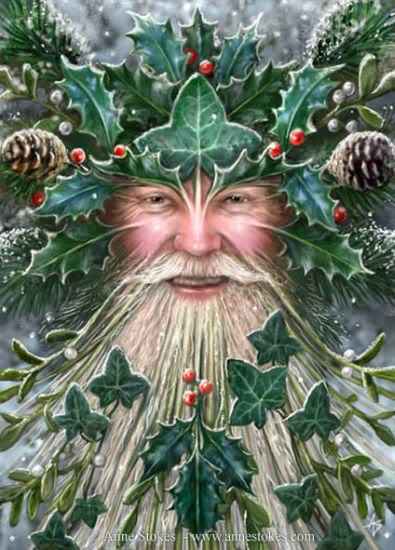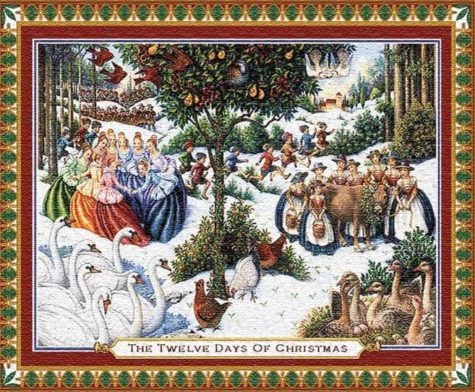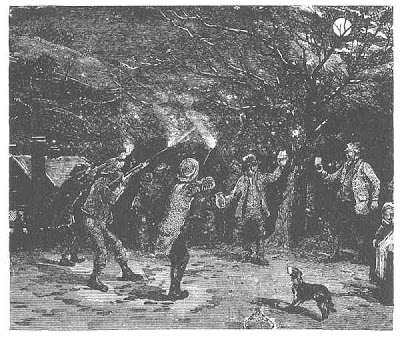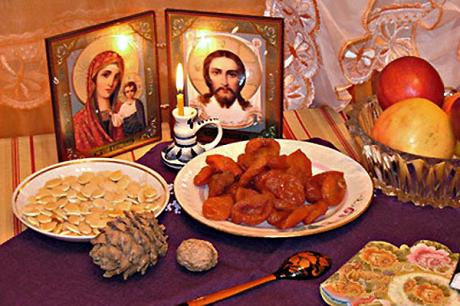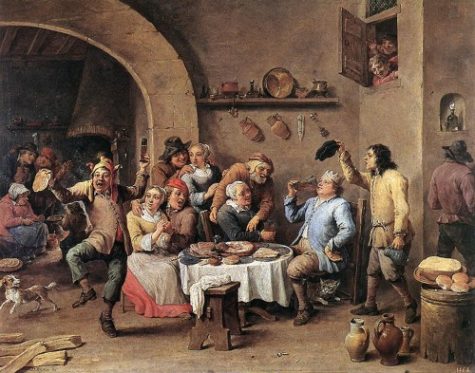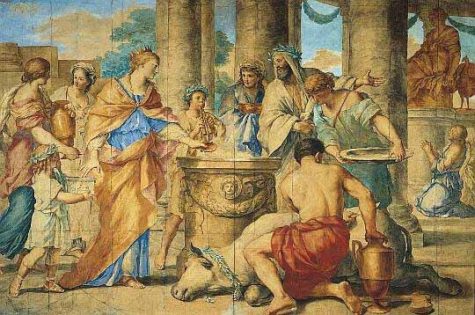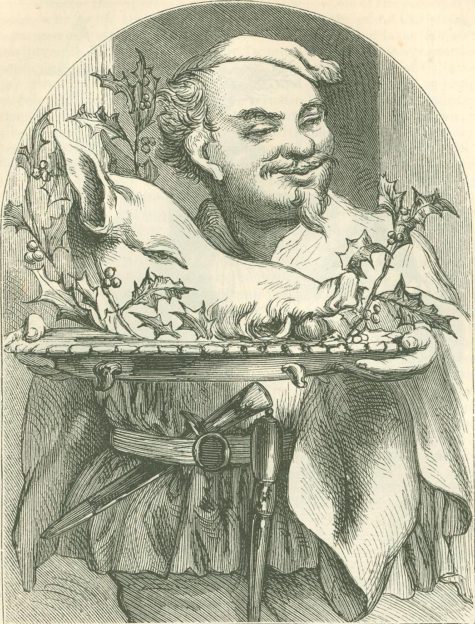Christmas Celebrations
Also known as Mithras (for the Persian Sun God), Saturnalia (for the Roman God of sowing and husbandry) and The Great Day of the Cauldron (from Druid Legend). It is the celebration of the return, or rebirth, of the Sun God, the Lord of Life. The celebrations were traditionally performed with the utmost solemnity, yet also with the highest rejoicing, for they resolve the paradox of Death and Rebirth. It represents the redemption of the world from Death and Darkness, as such it is a celebration of hope and joy amidst the gloom of winter.
The word Yule can be traced to the Celtic word `Hioul” which means wheel. This festival is an important point in the turning of the wheel of the year. Wreaths were made to symbolize this wheel, combining solar significance with tree-god significance. In ancient times Celts venerated trees as earthly representatives of the Gods, and it was felt that nothing short of the sacrifice of a mighty tree-god would cause the receding sun to take pity on them and return.
The burning of the Yule log was thought, through sympathetic magick, to increase the brightness and strength of the Sun, and would therefore bring good luck. Passersby would tip their hat or nod in salutation to the log. It is traditional to cut the log from oak or from a slow-burning fruit tree. The fire was lit from a piece of the previous years Yule log, which had been saved for this purpose. It was believed that this piece of the old log was a charm against fire, because it would refuse to burn until it was time to light its successor. A wish was also made while pouring wine over the burning log. It was believed to be bad luck if the log burned out before the 12 days of Yuletide were over. The ashes from the fire were spread in the fields to bring fertility to the next crop.
The Wassail bowl is another favored part of Yule celebrations. A large bowl or pot was filled with wassail, a mixture of cider and spices, and warmed over the Yule fire. The meaning of the word wassail is to be `hale or hearty’, and was the reason for the many toasts and salutations made from the bowl. It was also common for a procession to go to the nearest orchard and wassail the trees, thus blessing them and encouraging them to bear a good yield in the coming season. Libations of wassail were also poured over the roots of the trees, and cider drenched cakes were left in the forks of the older trees as an offering to the trees spirit.
Mistletoe is a regeneration symbol, considered to be the Essence of Life due to the resemblance of the juice of the berries to male semen. It was often gathered at this time. Evergreen boughs are also symbols of renewal. Evergreens were decorated to show honor to the tree spirits. The lights on modern trees were the candles of old, and represent the newly born sun god. Trees were not cut down and brought indoors.
The Sacred Seed of Life, having been nurtured by the foster mother Tailltiu, sprang forth from her breast, and was born. As the Wyrrd had foretold, here was the Child of Promise, son of the Gods and of the Earth. This baby was the Sun God, born in the Rule of Darkness, by the magick of the Gods. He was destined to grow in strength and knowledge. It was his task to bring back life and warmth to the land, and to wrest the power from the Lord of Darkness. To appease Cernunnos, who is at the peak of his strength, the people made sacrifices of roasted boar. To distract Callieach, the Wise Ones, or Witches invoked her to teach them of her mysteries. To aid the new-born Sun God the Celts felled a giant oak tree, and burned the log as a sacrifice, that the sun would gain strength from it, and grow.
Despite the powers of Cernunnos and Cailleach, the signs of new life were still upon the land. The sacred seeds which had fallen onto the barren branches of the winter-dead trees had come to life, and thus became the Mistletoe, which could be seen hanging from the oaks in the forests. Upon the land these sacred seeds had grown into the sweet smelling evergreens, and thus they were decreed to be a part of the celebration.
In honor of this magickal birth the people decorated the evergreens with candles and other symbols of life. The Druids told of Hu-Gadarn, the first druid, who had fled from the Atlalntean flood with his family on this day on the Ark, “The Great Cauldron” in which they brought the Essence of Life, and the knowledge of magick into the world. They would also tell tales of the Killing of the Wren, and of the Battle between the Oak King and the Holly King. Throughout the land the people rejoiced, and there was light in the midst of the darkness.
Blessed Be
~Lady Galadriel
From the earliest times the twelve days have been regarded as a time when supernatural events can easily happen, when the dead are close at hand and might often be seen.
One reads of the Wild Hunt, or the Fairy Host riding across the lands of Britain and Germany in particular, led by characters such as King Arthur, Woden, and Arawn, the Celtic god of the Underworld. In Ireland these supernatural hunters are known as the Yule Host, and in common with all these bands they are believed to gather up wandering souls and carry them away to the Otherworld.
The Twelve Days of Christmas stand outside of “ordinary time,” and celebrations focus on the return of the sun and a continuation of the eternal cycle of life.
The days from Christmas Eve on December 24th to Epiphany on the 6th of January (actually fourteen days as the first and last are not included in the twelve) really exist out of linear time. They are, in a sense, the fruit of the past year, one day for each month that has passed. Over the centuries the dates have changed – sometimes radically.
Here’s a list of commonly accepted dates and traditions:
- Day 0 – Dec 24 – Christmas Eve
- Day 1 – Dec 25 – Christmas Day, Birthday of Jesus, Mithras, Attis, Aion, Horus, Dionysus, and The Unconquered Sun.
- Day 2 – Dec 26 – St Stephen’s Day, Boxing Day, Day of the Wren
- Day 3 – Dec 27 – Mother Night, St John’s Day
- Day 4 – Dec 28 – Holy Innocent’s Day, Childremass, Dyzymas Day
- Day 5 – Dec 29 – Feast of Fools
- Day 6 – Dec 30 – Bringing in the Boar
- Day 7 – Dec 31 – New Year’s Eve, Hogmanay
- Day 8 – Jan 1 – New Year’s Day,
- Day 9 – Jan 2 – The Kalends of January
- Day 10: – Jan 3 – Snow Day
- Day 11 – Jan 4 – Evergreen Day
- Day 12 – Jan 5 – Twelfth Night
- Day 13 – Jan 6 – Epiphany,
When researching lore and magicks for the Twelve Days of Christmas I found a lot of disagreement as to the dates. So, from Wikipedia we have this explanation and additional information:
The Twelve Days of Christmas are the festive days beginning Christmas Day (25 December). This period is also known as Christmastide and Twelvetide. The Twelfth Night of Christmas is always on the evening of 5 January, but the Twelfth Day can either precede or follow the Twelfth Night according to which Christian tradition is followed. Twelfth Night is followed by the Feast of the Epiphany on 6 January. In some traditions, the first day of Epiphany (6 January) and the twelfth day of Christmas overlap.
Over the centuries, differing churches and sects of Christianity have changed the actual traditions, time frame and their interpretations. St. Stephen’s Day (or Boxing Day), for example, is 26 December in the Western Church and 27 December in the Eastern Church.Boxing Day, on December 26, is observed as a legal holiday in parts of the Commonwealth of Nations. 28 December is Childermas or the Feast of the Innocents.
Currently, the twelve days and nights are celebrated in widely varying ways around the world. For example, some give gifts only on Christmas Day, some only on Twelfth Night, and some each of the twelve nights.
In England in the Middle Ages, this period was one of continuous feasting and merrymaking, which climaxed on Twelfth Night, the traditional end of the Christmas season. Continue reading
Wassailing the trees occurred on old “twelfth night”, the 12th night after Christmas eve, or January 17th on the old calendar. (Other calendars show the date as January 5th.)
Obviously traditions varied, but in Devonshire, Herefordshire and in other parts of the West Country of England (as well as elsewhere no doubt) families would hold a feast with cakes, cider and in some areas beer and ale too. After a time of eating and drinking everyone trooped out to the orchard to wassail the trees, and wake them up from winter for the coming season as well as scare off any bad energy, spirits or demons.
Ale, beer or cider soaked toast, in some areas special cakes, would be placed in the tree branches or in a fork of the tree, and then be splashed with more cider. Trees might be beaten with sticks, pounded on, pots and pans clanged, and in appropriate eras, guns that had been loaded with just powder (no shot) would be fired at the trees.
While this went on, others in the group bowed their heads and sang the special “wassail song”.
Variations include:
Old apple tree, we’ll wassail thee
And hoping thou wilt bear
The Lord does know where we shall be
To be merry another year.
To blow well and to bear well
And so merry let us be
Let every man drink up his cup
And health to the old apple tree
(Spoken)
Apples now, hat-fulls, three bushel bag-fulls,
tallets ole-fulls, barn’s floor-fulls,
little heap under the stairs
Hip Hip Hooroo
Hip Hip Hooroo
Hip Hip Hooroo
source: Folk Info
The Nativity Fast is a period of abstinence and penance practiced by the Eastern Orthodox, Oriental Orthodox, and Eastern Catholic Churches, in preparation for the Nativity of Jesus, (December 25).
This is a joyous fast in anticipation of the Nativity of Christ. That is the reason it is less strict than other fasting periods. The fast is divided into two periods. The 1st period is November 15th through December 19th when the traditional fasting discipline (no meat, dairy, fish, wine, and oil) is observed.
There is dispensation given for wine and oil on Tuesdays and Thursdays. Similarly, fish, wine, and oil are permitted on Saturdays and Sundays. The 2nd period is December 20th through 24th when the traditional fasting discipline (no meat, dairy, fish, wine, and oil) is observed. There is dispensation given for wine and oil only on Saturday and Sunday during this period. Here are the guidelines:
- Meat – Abstain
This includes: beef, chicken, pork, turkey, elk, veal, lamb, deer, rabbit, buffalo, and so forth
- Dairy – Abstain
This includes milk, eggs, cheese, butter, yogurt, cream, and so forth
- Fish – Permitted only on Saturdays and Sundays before December 20.
This includes fish with a backbone, but does not include shrimp, octopus, shellfish, squid, or other seafood. Note: (some permit fish Tuesdays and Thursdays also)
- Wine – Permitted only on Tuesdays, Thursdays, Saturdays, and Sundays before December 20.
Some include all types of alcohol in this category.
- Oil – Permitted only on Tuesdays, Thursdays, Saturdays, and Sundays before December 20.
Abstinence includes refraining from the food and drink mentioned above, as well as from smoking. The Eucharistic Fast means abstaining from at least the previous midnight for communing at a morning Liturgy.
The Purpose of Fasting
The purpose of fasting is to focus on the things that are above, the Kingdom of God. It is a means of putting on virtue in reality, here and now. Through it we are freed from dependence on worldly things. We fast faithfully and in secret, not judging others, and not holding ourselves up as an example.
Fasting in itself is not a means of pleasing God. Fasting is not a punishment for our sins. Nor is fasting a means of suffering and pain to be undertaken as some kind of atonement. Christ already redeemed us on His Cross. Salvation is a gift from God that is not bought by our hunger or thirst.
- We fast to be delivered from carnal passions so that God’s gift of Salvation may bear fruit in us.
- We fast and turn our eyes toward God in His Holy Church.
- Fasting and prayer go together.
- Fasting is not irrelevant.
- Fasting is not obsolete, and it is not something for someone else.
- Fasting is from God, for us, right here and right now.
- Most of all, we should not devour each other.
- We ask God to “set a watch and keep the door of our lips.”
Do NOT Fast
- Between December 25 and January 5 (even on Wednesdays and Fridays);
- If you are pregnant or nursing a newborn;
- During serious illness;
- Without prayer;
- Without alms-giving;
- According to your own will without guidance from your spiritual father.
Source: Antiochian
 In Sweden, January 13, St Knut’s Day, is the traditional day to discard the Christmas tree and end the season’s festivities. A children’s party is the favored way to strip the tree of its decorations, after which the children are free to “plunder” the edible treats and small gifts placed on the tree especially for the occasion.
In Sweden, January 13, St Knut’s Day, is the traditional day to discard the Christmas tree and end the season’s festivities. A children’s party is the favored way to strip the tree of its decorations, after which the children are free to “plunder” the edible treats and small gifts placed on the tree especially for the occasion.
This Christmas tree plundering is often accompanied by smashing up the gingerbread houses and eating them while discarding of the decorations. Finally, everyone “dances” the tree out the door. Singing special songs, they pick up the tree and toss it out into the snow.
However in Finland, the tradition is quite different:
Called Nuutinpäivä, there has been a tradition somewhat analogous to modern Santa Claus, where young men dressed as a goat (Finnish: Nuuttipukki) would visit houses. Usually the dress was an inverted fur jacket, a leather or birch bark mask, and horns. Unlike Santa Claus, Nuuttipukki was a scary character.
The men dressed as Nuuttipukki wandered from house to house, came in, and typically demanded food from the household and especially leftover alcoholic beverages. In Finland the Nuuttipukki tradition is still living at areas of Satakunta, Southwest Finland and Ostrobothnia. However, nowadays the character is usually played by children and now involves a happy encounter.
A proverb from Noormarkku says:
Hyvä Tuomas joulun tua,
paha Knuuti poijes viä
“Good Thomas brings Christmas,
evil Knut takes it away.”
Courtesy of: almanac.com and Wikipedia
In Old England, The Twelfth Night marked the end of the winter festival that started on Samhain. The Lord of Misrule symbolizes the world turning upside down with the coming of winter. In the middle ages, the Twelfth Night began on the eve of December 25th moving forward 12 days to January 6th, hence the name the twelve days of Christmas.
The Twelfth Night festival marked the onset of the winter solstice, the point in late December when the sun, whose daily arc had reached its lowest, darkest, coldest point, began its rise toward the longer, warmer days and the coming of spring. On December 25th, the ceremonial Yule log was hauled in to start the hearth fire around which its members and visitors would gather throughout the rest of the Christmas festival days.
Twelfth Night was the final frenzy of feasting, drinking and merry making before the townspeople returned to daily life for the remainder of winter. A grand cake was the focus of the celebratory feast as well as Wassail, Fig Pudding and other generous tasty handmade dishes.
In the ancient times of the Roman Saturnalia, the “king of the feast” was elected by beans, and the Twelfth Night cakes included a bean–or, later, a ring or coin. Whoever was given the slice with the prize became the queen and king for the night and much parading and merriment followed.
In the church calendar, Twelfth Night is the evening before Epiphany (January 6). Because the three wise men (or kings) arrived in Bethlehem bearing gifts for the infant Jesus, Epiphany is also called Three Kings Day and a traditional time of gift giving.
Sources: White Magick Alchemy and Almanac.com
The Kalends of January (Jan 2nd, the 9th day of Christmas) was a significant part of the Roman Midwinter celebrations, and has lent its name to Midwinter festivals all over the Western world. For example, in Provence in France the festival is known as Calendas, in Poland it is called Kolenda, and in Russia, Kolyada. In the Czech Republic it is called Koteda, in Lithuania, Kalledos, and in Wales and Scotland, Calenig and Calluinn respectively – all these names derived from the Latin Kalendae, and all referring to the festival of midwinter.
Initially the Kalends followed Saturnalia, beginning a few days of rest to allow aching heads and stomachs to recover! At this time new consuls were inducted into office, and for at least three days a high festival took place.
Houses were decorated with lights and greenery and gifts were exchanged. It was also the custom to give special presents to the emperor. These, called Votae, were left in the porch of the imperial palace, and it is recorded that the Emperor Calligula not only demanded these gifts from everyone, but also stood in the porch to collect them personally!
It may have been the memory of this that prompted the 4th century writer Libanius to describe the festival in terms that might be easily applied to the modern celebration of Christmas as to the celebrations in ancient Rome:
The impulse to spend seizes everyone..
People are not only generous themselves,
but also towards their fellow men.
A stream of presents pours itself out on all sides.
The Kalends festival banishes all that is
connected with toil, and allows men to give
themselves up to undisturbed enjoyment.
From the minds of young people it
removes two kinds of dread:
the dread of the schoolmaster and
the dread of the pedagogue.
The slave also it allows, as far as possible,
to breathe the air of freedom…
Another great quality of the festival
is that it teaches men not to hold too fast
to their money, but to part with it
and let it pass into other hands.
Source: The Winter Solstice
The sixth day of Christmas (Dec 30) is the day of “Bringing in the Boar.” Two traditions honor the importance of the boar at Solstice tide. In Scandinavia, Frey, the god of sunshine, rode across the sky on his golden-bristled boar. Gulli-burstin, who was seen as a solar image, his spikes representing the rays of the sun.
In the ancient Norse tradition, the intention was to gain favor from Frey in the new year. The boar’s head with an apple in his mouth was carried into the banquet hall on a gold or silver dish to the sounds of trumpets and the songs of minstrels.
In Scandinavia and England Saint Stephen (whose feast day is Dec 26) is shown as tending to horses and bringing a boar’s head to a Yuletide banquet. Christmas ham is an old tradition in Sweden and may have originated as a winter solstice boar sacrifice to Freyr.
Here’s a song from 1607:
The Boar is dead,
Lo, here is his head,
What man could have done more
Than his head off to strike,
Meleager like.
And bring it as I do before.
His living spoiled,
Where good men toiled,
Which makes kind Ceres sorry;
But now, dead and drawn,
he is very good brawn,
And we have brought it for ye.
Then set down the swineherd,
The foe of the vineyard,
Let Baccus crown his fall;
Let this boar’s head and mustard,
Stand for pig,goose and custard,
And so ye are welcome all.
From: The Winter Solstice and other sources.
The Feast of Fools, the fifth day of Christmas, (Dec 29), is a day when the normal order of things was ceremonially reversed, has been neglected for a long while – unfortunately, as it could well serve in our own times as a safe way of letting off steam. Essentially, it allowed people who were restricted from even the most casual of pleasure by the Church, to act in an abandoned way. It was also a time of festivity that was both part of, and sometimes even superseded, Christmas.
So, why not celebrate the Feast of Fools by having your own party where things get reversed, where your guests are invited to act as foolish as they can? Here are some ideas:
- Invite your guests to wear silly clothes
- Provide a box of silly or outrageous accessories – hats, shoes, wigs, gloves… use your imagination
- Have everyone paint their faces, or fingernails in wild colors (men as well as women)
- Organize a food fight or a pie throwing contest.
- Provide helium balloons so every one can talk funny.
For a great party game ask your guests to each write down a forfeit – an action that involves something very silly such as shaving with real cream, singing the words of one song to the tune of another, juggling with oranges – whatever they like. Then each guest should pull out a forfeit from the hat and do their best to obey the instruction.
If you are alone, you can still act the fool. Here are some suggestions:
- Make goofy faces at yourself in the mirror
- Wear your own clothes inside out and backwards
- Make a video or other recording of yourself laughing hysterically (fake it until you make it).
Above all, let this be a day of joyful fun and blissful games…
From: The Winter Solstice
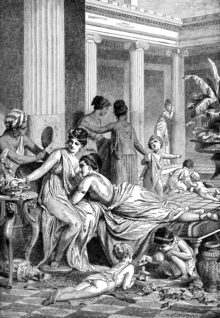 In Athens and other parts of ancient Greece, there is a month that corresponds to roughly December/January that is named Poseideon for the sea-god Poseidon. The Poseidonia of Aegina may have taken place in the same month. Presumably on or around the Winter Solstice.
In Athens and other parts of ancient Greece, there is a month that corresponds to roughly December/January that is named Poseideon for the sea-god Poseidon. The Poseidonia of Aegina may have taken place in the same month. Presumably on or around the Winter Solstice.
There were 16 days of feasting with rites of Aphrodite concluding the festival. Like the Roman festival of Saturnalia, the Poseidonia became so popular it was extended so that Athenaeus makes it 2 months long.
Poseidon as savior of ships, protector of those who voyage in ships, and God of the lapping waters both salt and fresh important for agriculture, is thanked for the many gifts that came from faraway places that were likely given at that time. The immense trade and distribution was nearly all through shipping, relatively little overland, whether it be perfume from Cyprus or pottery from Corinth.
It is interesting today that Agios Nikolaos (Saint Nikolas) is the Patron Saint of seafarers in the Orthodox Church. Celebrating Poseidon’s Festival seems to be lost in modern practice. It likely entailed bonfires, feasting, cutting of trees (probably decorated), and very likely gift giving. As God of begetting, that aspect was not forgotten.
The most complete account of the festival is Noel Robertson’s article Poseidon’s Festival at the Winter Solstice, The Classical Quarterly, New Series, Vol. 34, No. 1. (1984), pp. 1-16:
“The record shows that Poseidon was once worshiped in every part of Greece as a god of general importance to the community.”
“The festival falls near the winter solstice, and the ritual business marked by jollity and license, belongs to the general type of solstice festival known the world over. At Poseidon’s festival, however, the sportive conduct has a definite purpose; this purpose arises from the fundamental agrarian background if Mediterranean society, and may bring us close to the origin of solstice festivals.”
“It has scarcely been noticed that festivals of Poseidon, more than those of any other Greek deity, fall at just this time of year; yet the evidence is extensive.”
“The festival Poseidea and some of the rites in question are often claimed for Poseidon the sea-god, but at this season sailing is furthest from one’s mind, and fishing on the shore is by no means an overriding concern. Such details as we have point elsewhere, to Poseidon as the god of fresh water who fructifies Demeter’s fields.”
One of Poseidon’s epithets is prosklystios, ‘of the lapping water’. He is also invoked as Poseidon phytalmios which implies natural fertility and human procreation. There are also implications in the legends that imply bonfires at the winter solstice.
Noel Robertson concludes:
“…the celebrants feast to satiety, then turn to lascivious teasing. What is the ritual purpose of such conduct? It obviously suits Poseidon’s mythical reputation as the most lustful of gods, who far surpasses Apollo and Zeus in the number of his liaisons and his offspring. Poseidon the seducer is the god of springs and rivers; his women typically succumb while bathing or drawing water; the type of the river god is a rampant bull. But the ritual likewise treats Poseidon as a procreant force; witness the epithets phytalmios, genesios, pater, etc. as interpreted above. The myths and the ritual reflect the same belief. The rushing waters are a proponent male power, just as the fields which they fertilize are a prolific female. Both water and the fields, both Poseidon and Demeter, can be made to operate by sympathetic magic. The rites of our winter festival rouse Poseidon and bring the rushing waters…”
It is interesting that that Theophrastus tells us that the silver fir was important in ship building, especially for masts. The ‘tannenbaum’ is a silver fir. It is also interesting to compare with the Roman Saturnalia which may very well have borrowed from the Poseidea.
